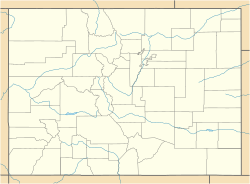Telluride Historic District facts for kids
|
Telluride Historic District
|
|

Telluride from a hiking trail above, in 2005
|
|
| Location | Rt. 145, Telluride, Colorado |
|---|---|
| Area | 87 acres (35 ha) |
| Built | 1878 |
| Architect | Multiple |
| Architectural style | Late Victorian, Gothic Revival |
| NRHP reference No. | 66000256 |
Quick facts for kids Significant dates |
|
| Added to NRHP | October 15, 1966 |
| Designated NHLD | July 4, 1961 |
The Telluride Historic District is a special area in Telluride, Colorado. It protects many old buildings from when Telluride was a busy mining town. The town started in 1878. It was a big center for mining metals until 1913. This historic district covers about 80 acres. It includes downtown Telluride and some homes. It also has the town's first cemetery, Lone Tree Cemetery. This area was named a National Historic Landmark in 1961. It's famous for its well-kept buildings from the "boom town" era.
Telluride's Exciting History
Telluride's story began in 1875. That's when silver was found nearby. This discovery led to a big mining camp. The town officially started in 1878. Telluride became very important for mining. A wagon road was built in 1882. This helped move the mined ores. Then, the railroad arrived in 1890. This made it even easier to transport ores. The railroad also caused a building boom. Many of the historic buildings you see today were built then.
How Telluride Was Built
The historic district includes most of Colorado Street. This street was the town's main shopping area. Telluride was planned like many other "boom towns." These were towns that grew very quickly. Nicer houses were built on the hill above the main street. Simpler homes and work areas were located below.



